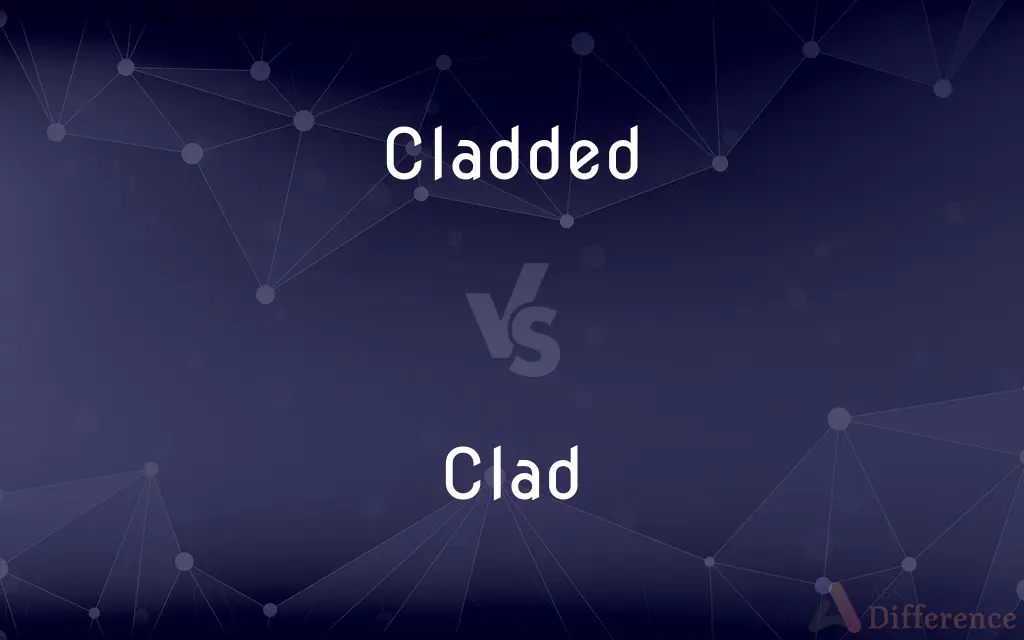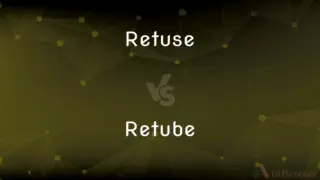Cladded vs. Clad — What's the Difference?
By Fiza Rafique & Maham Liaqat — Updated on April 4, 2024
"Cladded" and "clad" both refer to the process of covering one material with another, but "clad" is the preferred and more commonly used term in modern English.

Difference Between Cladded and Clad
Table of Contents
ADVERTISEMENT
Key Differences
"Cladded" might appear as the past participle form of the verb "to clad," implying the action of covering a material with another. This usage, however, is less common and often considered non-standard in contemporary English. On the other hand, "clad" is widely accepted and used both as the past tense and past participle of "to clad," indicating that a material has been covered or coated with another. It is recognized for its brevity and historical usage in various contexts.
While "cladded" can sometimes be found in technical or regional dialects, emphasizing the completion of the cladding process, "clad" is universally understood and applies to a broader range of contexts, from construction and materials science to fashion and metaphorical expressions. "Clad" succinctly conveys the action without the need for an additional syllable, aligning with the tendency in English to favor more concise linguistic forms.
In terms of documentation and formal writing, especially in engineering, architecture, and construction, "clad" is the term predominantly seen and recommended by style guides and dictionaries. It integrates smoothly into professional discourse, reflecting a standardization that "cladded" lacks. Whereas "cladded" may occasionally emerge in informal discussions or within specific niches, reinforcing a more casual or less conventional tone.
The choice between "cladded" and "clad" often reflects not just a linguistic preference but an alignment with the norms and expectations of the audience or field. While "clad" demonstrates adherence to established standards, the use of "cladded" might suggest either a regional vernacular or a departure from mainstream linguistic conventions.
Recognizing the distinction is crucial for clear communication, particularly in industries where material specifications and processes are discussed. Adhering to the standard terminology ensures that descriptions and instructions are accurately interpreted and executed, minimizing misunderstandings in professional settings.
ADVERTISEMENT
Comparison Chart
Usage
Less common, often considered non-standard.
Widely accepted and used, both past tense and participle.
Context
Sometimes found in technical or regional dialects.
Applicable in various contexts, including construction and fashion.
Preferred in Formal Writing
Rarely preferred; "clad" is recommended.
Recommended by style guides and dictionaries.
Syllabication
Two syllables: clad-ded.
One syllable: clad.
Implication
May emphasize the completion of the cladding process.
Concisely indicates covering one material with another.
Compare with Definitions
Cladded
Often seen in specific dialects or informal contexts.
The walls were cladded with wood to give a cozy feeling.
Clad
The past tense and participle of "to clad," indicating covering with another material.
The building was clad in glass to enhance natural light.
Cladded
Supposed past participle of "to clad," less commonly used.
The building was cladded in marble for a luxurious finish.
Clad
Conveys action efficiently and succinctly.
The warriors were clad in armor before the battle.
Cladded
Occasionally used to emphasize the action's completeness.
Once the vessel was cladded, it underwent inspection.
Clad
Universally accepted in various professional and casual contexts.
She was clad in a velvet dress that turned heads.
Cladded
Can imply a recent action of covering material.
The tank was newly cladded to prevent leaks.
Clad
Indicates a process or result of covering materials.
The exterior walls are clad with limestone for durability.
Cladded
Might appear in technical descriptions within certain industries.
The cladded pipes are resistant to corrosion.
Clad
Used in technical, architectural, and fashion descriptions.
The structure is clad in a material that mimics the local stone.
Cladded
Simple past tense and past participle of clad
Clad
To sheathe or cover (a metal) with a metal.
Clad
To cover with a protective or insulating layer of other material.
Clad
A past tense and a past participle of clothe.
Clad
(archaic) clothe
Clad
To clothe, to dress.
Clad
To cover with a cladding or another material (for example, insulation).
Clad
To imbue (with a specified quality); to envelop or surround.
Clad
Wearing clothing or some other covering (for example, an armour) on the body; clothed, dressed.
Clad
S}} Covered, enveloped in, or surrounded by a cladding, or a specified material or substance.
Clad
(figurative) Adorned, ornamented.
Clad
To clothe.
Clad
Wearing or provided with clothing; sometimes used in combination;
Clothed and in his right mind
Proud of her well-clothed family
Nurses clad in white
White-clad nurses
Clad
Having an outer covering especially of thin metal;
Steel-clad
Armor-clad
Common Curiosities
Why is "clad" more common than "cladded"?
"Clad" aligns with English linguistic preferences for conciseness and has historical precedence, making it more widely accepted.
When should I use "clad"?
Use "clad" in both formal and informal contexts to refer to the act of covering something with another material.
Can "clad" and "cladded" be used interchangeably?
Although they convey similar meanings, "clad" is preferred for its standard usage and brevity.
What does "clad" mean?
"Clad" means to cover one material with another, often for protection or aesthetics.
What is the importance of using the correct term in professional settings?
Using the correct term ensures clarity, professionalism, and adherence to industry standards, facilitating effective communication.
Does "clad" have any specific connotations?
"Clad" is neutral, simply indicating the process of covering, but the context can add connotations related to protection, decoration, or transformation.
Is "cladded" a correct term?
While "cladded" can be understood, it's less common and considered non-standard compared to "clad."
What are some examples of materials that can be clad?
Examples include buildings clad in metal, pipes clad with insulation, and individuals clad in protective clothing.
How can I remember when to use "clad" over "cladded"?
Remember that "clad" is the standard form for both past and past participle, favored for its conciseness and clarity.
Can "clad" be used in a metaphorical sense?
Yes, "clad" can be used metaphorically to describe being enveloped or covered in non-material ways, e.g., clad in mystery.
Are there any industries where "clad" is particularly important?
Yes, construction, architecture, fashion, and materials science often use "clad" to describe covering processes.
Are there any regions where "cladded" is more commonly used?
"Cladded" may appear more frequently in certain dialects or regions, though it's generally considered less standard.
Is "cladded" recognized in any dictionaries?
Some dictionaries may list "cladded" as a variant, but they typically highlight "clad" as the standard form.
How has the use of "clad" evolved over time?
"Clad" has maintained its role as the preferred term for covering materials, reflecting the English language's tendency towards efficiency and conciseness.
How does the choice between "clad" and "cladded" reflect on the speaker or writer?
The choice can reflect the individual's familiarity with standard English usage, with "clad" indicating adherence to conventional standards.
Share Your Discovery

Previous Comparison
Retuse vs. Retube
Next Comparison
Continue vs. ProcessAuthor Spotlight
Written by
Fiza RafiqueFiza Rafique is a skilled content writer at AskDifference.com, where she meticulously refines and enhances written pieces. Drawing from her vast editorial expertise, Fiza ensures clarity, accuracy, and precision in every article. Passionate about language, she continually seeks to elevate the quality of content for readers worldwide.
Co-written by
Maham Liaqat














































